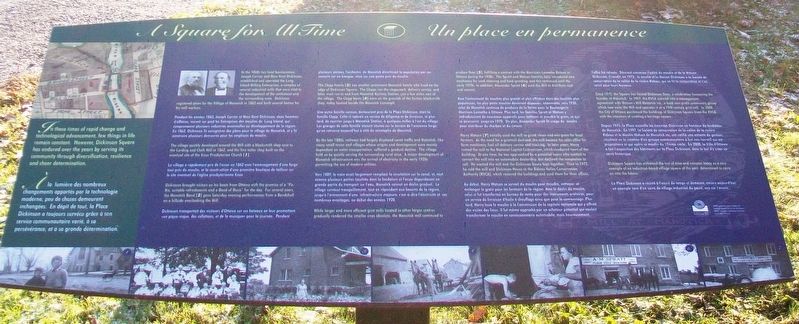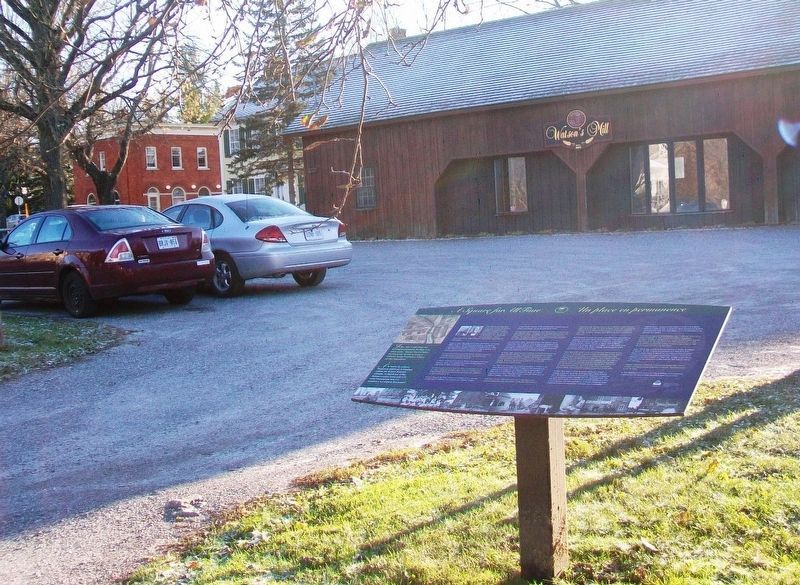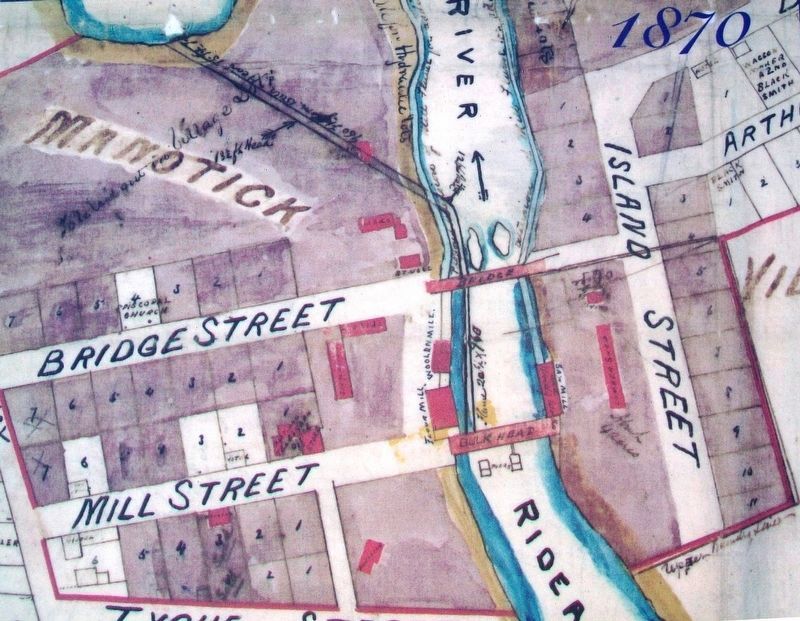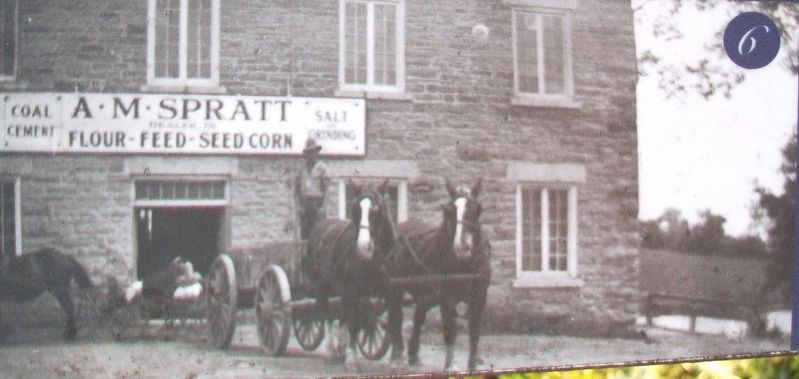Manotick in Ottawa, Ontario — Central Canada (North America)
A Square for All Time / Un place en permanence
Inscription.
In these times of rapid change and technological advancement, few things in life remain constant. However, Dickinson Square has endured over the years by serving its community through diversification, resilience and sheer determination.
In the 1860s two local businessmen, Joseph Currier and Moss Kent Dickinson, established and operated the Long Island Milling Enterprises, a complex of several industrial mills that were vital to the development of the settlement and the surrounding area. Dickinson registered plans for the Village of Manotick in 1862 and built several homes for his mill workers.
The village quickly developed around the Mill with a blacksmith shop next to the Carding and Cloth Mill in 1862, and the first tailor shop built on the eventual site of the Knox Presbyterian Church [1].
Dickinson brought visitors on his boats from Ottawa with the promise of a "Pic-Nic, suitable refreshments and a Band of Music" for the day. For several years, the Manotick Band [2] gave Saturday evening performances from a Bandshell on a hillside overlooking the Mill.
The Clapp family [3] was another prominent Manotick family who lived on the edge of Dickinson Square. The Clapps ran the stagecoach, delivery service, and later, mail run to and from Manotick Railway Station, just a few miles east of the village. The Clapp barns [4] were on the grounds of the former blacksmith shop, today located beside the Manotick Cenotaph.
By the late 1880s, railways had largely displaced canal traffic and Manotick, like many small towns and villages whose origins and development were mainly dependent on water transportation, suffered a gradual decline. The village held on by quietly serving the surrounding rural area. A major development of Manotick infrastructure was the arrival of electricity in the early 1920s permitting the use of modern utilities.
While larger and more efficient grist mills located in other larger centres gradually rendered the smaller ones obsolete, the Manotick mill continued to produce flour [5], fulfilling a contract with the Morrison-Lamothe Bakery in Ottawa during the 1930s. The Spratt and Watson families later introduced new machinery for seed-cleaning and feed-grinding, and this continued until the early 1970s. In addition, Alexander Spratt [6] used the Mill to distribute coal and cement.
Harry Watson [7] initially used the mill to grind, clean and mix grain for local farmers. As the
need for a gristmill declined, the mill became his sales office for farm machinery, fuel oil delivery service and trucking. In later years, Harry rented the mill to the National Capital Commission, which conducted tours of the building. At one time, he was approached by a potential buyer who wanted to convert the mill into an automobile dealership, but declined the temptation to sell. He wanted the mill and the Dickinson house kept together. Then in 1972, he sold the mill and Dickinson House to the Rideau Valley Conservation Authority (RVCA), which restored the buildings and used them for their offices.
Since 1975, the Square has hosted Dickinson Days, a celebration honouring the founder of Manotick. In 1997, the RVCA entered into a management agreement with Watson's Mill Manotick Inc., a local non-profit community group which now owns the Mill and operates it as a 19th century grist mill. In 2008, the City of Ottawa purchased the buildings of Dickinson Square from the RVCA with the intention of creating a heritage square.
Dickinson Square has withstood the test of time and remains today as a rare example of an industrial-based village square of the past, determined to carry on into the future.
———————————————————
dépit de tout, la Place Dickinson a toujours survécu grâce à son service communautaire varié, à sa persévérance, et à sa grande détermination.
Pendant les années 1860, Joseph Currier et Moss Kent Dickinson, deux hommes d'affaires, mirent sur pied les Enterprises des moulins de Long Island, qui comprenaient plusieurs industries essentielles au développement de la région. En 1862, Dickinson fit enregistrer des plans pour le village de Manotick, et y fit construire plusieurs demeures pour les employés du moulin.
Le village a rapidement pris de l'essor en 1862 avec l'aménagement d'une forge tout près du moulin, et la construction d'une première boutique de tailleur sur le site éventuel de l'église presbytérienne Knox.
Dickinson transportait des visiteurs d'Ottawa sur ses bateaux en leur promettant «un pique-nique, des collations, et de la musique» pour la journeé. Pendant plusieurs années, l'orchestre de Manotick divertissait la population par ses concerts sur un kiosque, situé sur une pente près du moulin.
Une autre famille connue, demeurant près de la Place Dickinson, était la famille Clapp. Celle-ci opérait un service de diligence et de livraison, et plus tard, de courrier jusqu'à Manotick Station, à quelques milles à l'est du village. Les granges de cette famille étaient situées sur le terrain de l'ancienne forge, qu'on retrouve aujourd'hui à
côté du cénotaphe de Manotick.
Vers 1889, le train avait largement remplacé la circulation sur le canal, et, tout comme plusieurs petites localités dont la fondation et l'essor dépendaient en grande partie du transport sur l'eau, Manotick connut un déclin graduel. Le village survécut tranquillement, tout en répondant aux besoins de la région, jusqu'à l'avènement d'une infrastructure majeure, c'est-à-dire l'électricité et ses nombreux avantages, au début des années 1920.
Avec l'avènement de moulins plus grands et plus efficaces dans des localités plus populeuses, les plus petits moulins devinrent dépassés; néanmoins, vers 1930, celui de Manotick continua de produire de la farine pour la Boulangerie Morrison-Lamothe à Ottawa. Plus tard, les familles Spratt et Watson y indroduisirent de nouveaux appareils pour nettoyer et moudre le grain, ce qui se poursuivit jusqu'en 1970. De plus, Alexander Spratt fit usage du moulin pour distribuer du charbon et du ciment.
Au début, Harry Watson se servait du moulin pour moudre, nettoyer et mélanger le grain pour les fermiers de la région. Avec le déclin du moulin, celui-ci fut transformé en bureau de vente pour des instruments aratoires, pour un service de livraison d'huile à chauffage ainsi que pour le camionnage. Plus tard, Harry loua le moulin à la Commission de la capitale nationale qui y offrait des visites des lieux. Il fut même approché par un acheteur potentiel qui voulait transformer le moulin en concessionnaire automobile, mais heureusement, l'offre fut refusée. Désirant conserver l'entité du moulin et de la Maison Dickinson, il vendit, en 1972, le moulin et la Maison Dickinson à la Société de conservation de la vallée de la rivière Rideau, qui en fit la restauration et s'en servit pour leurs bureaux.
Depuis 1975, la Place accueille les Journées Dickinson en honneur du fondateur de Manotick. En 1997, la Société de conservation de la valleé de la rivière Rideau et le Moulin Watson de Manotick inc. ont ratifié une entente de gestion, résultant en la création d'un groupe communautaire à but non-lucratif qui est propriétaire et qui opère ce moulin du 19ième siècle. En 2008, la Ville d'Ottawa a fait l'acquisition des bâtiments sur la Place Dickinson, dans le but d'y créer un carré historique.
La Place Dickinson a résisté à l'usure du temps et demeure, encore aujourd'hui, un exemple rare d'un carré de village industriel du passé, axé sur l'avenir.
Erected by Watson's Mill Manotick, Inc. and City of Ottawa.
Topics. This historical marker is listed in these topic lists: Charity & Public Work • Industry & Commerce • Man-Made Features • Settlements & Settlers. A significant historical year for this entry is 1862.
Location. 45° 13.625′ N, 75° 41′ W. Marker is in Ottawa, Ontario. It is in Manotick. Marker is at the intersection of Dickinson Street and Johnston Clapp Lane, on the left when traveling north on Dickinson Street. Touch for map. Marker is at or near this postal address: 5525 Dickinson Street, Ottawa ON K4M 1A2, Canada. Touch for directions.
Other nearby markers. At least 8 other markers are within walking distance of this marker. Carriage Shed / Hangar à chariots (a few steps from this marker); The Long Island Mill (within shouting distance of this marker); Dickinson Square and Manotick / La Place Dickinson et Manotick (within shouting distance of this marker); War Memorial Cenotaph (within shouting distance of this marker); Manotick Remembrance Park / Parc du Souvenir de Manotick (within shouting distance of this marker); Family Life / la vie familiale (within shouting distance of this marker); Peacekeeping / Casques bleus (within shouting distance of this marker); Homefront / Front intérieur (within shouting distance of this marker). Touch for a list and map of all markers in Ottawa.
Also see . . .
1. Dickinson Square. Team TwentyOne website entry (Submitted on January 6, 2018, by William Fischer, Jr. of Scranton, Pennsylvania.)
2. Dickinson Square Contemporary History. The Manotick Directory website entry (Submitted on January 6, 2018, by William Fischer, Jr. of Scranton, Pennsylvania.)
3. Watson’s Mill and Dickinson House. Heritage Ottawa website entry (Submitted on January 3, 2022, by Larry Gertner of New York, New York.)
4. Watson's Mill History. Mill website homepage (Submitted on January 6, 2018, by William Fischer, Jr. of Scranton, Pennsylvania.)
5. Watson's Mill, Manotick. YouTube video (2m 37s) (Submitted on January 6, 2018, by William Fischer, Jr. of Scranton, Pennsylvania.)
Credits. This page was last revised on January 3, 2022. It was originally submitted on January 6, 2018, by William Fischer, Jr. of Scranton, Pennsylvania. This page has been viewed 207 times since then and 16 times this year. Photos: 1, 2, 3, 4. submitted on January 7, 2018, by William Fischer, Jr. of Scranton, Pennsylvania.



